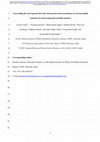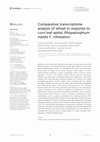Papers by PREM LAL KASHYAP

Frontiers in Microbiology
The current study describes a new diagnostic method for the rapid and accurate detection of Tille... more The current study describes a new diagnostic method for the rapid and accurate detection of Tilletia indica, the pathogen accountable for causing Karnal bunt (KB) disease in wheat. This method uses quantitative real-time polymerase chain reaction (qPCR) and a primer set derived from glyceraldehyde 3-phosphate dehydrogenase (GAPDH) gene of T. indica to identify the presence of the pathogen. The qPCR assay using this primer set was found highly sensitive, with a limit of detection (LOD) value of 4 pg of T. indica DNA. This level of sensitivity allows for the detection of the pathogen even in cases of different growth stages of wheat, where no visible symptoms of infection on the wheat plants can be seen by naked eyes. The study also validated the qPCR assay on ten different wheat cultivars. Overall, this study presents a valuable molecular tool for rapid, specific and sensitive detection of KB fungus in wheat host. This method has practical applications in disease management, screenin...
Indian Journal of Genetics and Plant Breeding, 2019
Frontiers in Microbiology, Jan 15, 2020
Wiley eBooks, Dec 15, 2017

Frontiers in sustainable food systems, Jun 2, 2023
Human efforts to grow abundant food through the persistent use of resourceintensive farming pract... more Human efforts to grow abundant food through the persistent use of resourceintensive farming practices have resulted in declining soil health, and deterioration of ecosystem functions and services. Conservation agriculture (CA) has emerged as a practice to minimize the impacts of conventional resource-exhaustive and energy-intensive agriculture. Minimum soil disturbance, permanent soil cover, and diversification are the key components of CA. Tillage through conventional practices on the other hand has detrimental effects on the soil and environment as it requires deep inversion of soil with instruments such as mouldboard plow, disc plow etc. leaving very less organic matter in soil after establishment of crop. Even though, CA advocates many benefits over conventional agriculture in terms of soil and water conservation, the consequent changes in moisture and temperature regimes due to reduced tillage and surface cover would likely going to influence the biological activity, including insect pests and their natural enemies which dwell within these agroecosystems. The changed crop conditions under CA may favor particular insect communities and their ecological niches. The adoption of such practices may lead to decrease in insect pests with major activity on the crop canopy. However, the activity of the insect pests that spend their maximum life span at the soil surface or beneath the soil surface may increase. Recent insect-pest outbreaks in NorthWestern India and imbalances reported in Indo-Gangetic Plains point to the need for a better understanding of the interrelationships between tillage intensity, residue retention, and insect pest population dynamics. The current review analyzes the existing state of knowledge of these dynamics and presents the scenarios that may emerge as CA get more acceptance. This review will help to develop countermeasures to improve performance and ecosystem services of Conservation agriculture (CA) based cropping systems.
Rhizosphere biology, 2022
Journal of Fungi, Aug 5, 2022
This article is an open access article distributed under the terms and conditions of the Creative... more This article is an open access article distributed under the terms and conditions of the Creative Commons Attribution (CC BY
Molecular Biotechnology, Jul 22, 2014

ABSTRACTThe study was conducted to identify novel simple sequence repeat (SSR) markers associated... more ABSTRACTThe study was conducted to identify novel simple sequence repeat (SSR) markers associated with resistance to corn aphid (CLA),Rhopalosiphum maidisL. in 48 selected bread wheat (Triticum aestivumL.) and wild wheat (Aegilopsspp. &T. dicoccoides) genotypes during two consecutive cropping seasons (2018-19 and 2019-20). A total of 51 polymorphic markers containing 143 alleles were used for the analysis. The frequency of the major allele ranged from 0.552 (Xgwm113) to 0.938 (Xcfd45, Xgwm194andXgwm526), with a mean of 0.731. Gene diversity ranged from 0.116 (Xgwm526) to 0.489 (Xgwm113), with a mean of 0.354. The polymorphic information content (PIC) value for the SSR markers ranged from 0.107 (Xgwm526) to 0.370 (Xgwm113) with a mean of 0.282. The results of the STRUCTURE analysis revealed the presence of four main subgroups in the populations. Analysis of molecular variance (AMOVA) showed that the between-group difference was around 37% of the total variation contributed to the div...

Frontiers in Plant Science
Aphids are one of the most important insect pests of wheat crop in all wheat growing regions of t... more Aphids are one of the most important insect pests of wheat crop in all wheat growing regions of the world. Amongst various aphid species, the corn leaf aphid (Rhopalosiphum maidis F.) is considered one of the most destructive insect pests of wheat in the North Western Plains region of India. Transcriptome profiling of highly susceptible wheat Triticum durum genotype, A-9-30-1 and tolerant wheat Triticum aestivum genotype, HD2967 was performed to investigate aphid-host interactions. The results obtained from differential gene expression analysis of R. maidis on the highly susceptible genotype, A-9-30-1 plants, when compared with the tolerant genotype, HD2967, showed that 212 genes were significantly upregulated and 1009 genes were significantly downregulated. Our findings demonstrated that the genes associated with defense were significantly higher in response to R. maidis on HD2967 as compared to A-9-30-1. Additionally, various genes with physiological attributes were expressed duri...

Frontiers in Microbiology
The present study deals with whole genome analysis of Fusarium udum, a wilt causing pathogen of p... more The present study deals with whole genome analysis of Fusarium udum, a wilt causing pathogen of pigeon pea. The de novo assembly identified a total of 16,179 protein-coding genes, of which 11,892 genes (73.50%) were annotated using BlastP and 8,928 genes (55.18%) from KOG annotation. In addition, 5,134 unique InterPro domains were detected in the annotated genes. Apart from this, we also analyzed genome sequence for key pathogenic genes involved in virulence, and identified 1,060 genes (6.55%) as virulence genes as per the PHI-BASE database. The secretome profiling of these virulence genes indicated the presence of 1,439 secretory proteins. Of those, an annotation of 506 predicted secretory proteins through CAZyme database indicated maximum abundance of Glycosyl hydrolase (GH, 45%) family proteins followed by auxiliary activity (AA) family proteins. Interestingly, the presence of effectors for cell wall degradation, pectin degradation, and host cell death was found. The genome compr...
The Plant Microbiome in Sustainable Agriculture

Frontiers in Microbiology
Microbial interactions with plant roots play an imperial role in tomato plant growth and defense ... more Microbial interactions with plant roots play an imperial role in tomato plant growth and defense against the Rhizoctonia solani. This study performed a field experiment with two antagonistic bacteria (Pseudomonas and Bacillus) inoculated in healthy and Rhizoctonia solani treated soil in tomato rhizosphere to understand the metabolic pattern and microbial function during plant disease suppression. In the present study, we assessed soil and microbial enzymes, bacterial and fungal cell forming unit (CFU), and carbon utilization profiling through Bio-Eco plates of rhizoplane samples. Antagonist bacteria and pathogen interaction significantly (p < 0.05) influenced the bacterial count, soil enzymes (chitinase and glucanase), and bacterial function (siderophore and chitinase production). These results indicated that these variables had an imperial role in disease suppression during plant development. Furthermore, the metabolic profiling showed that carbon source utilization enhanced und...

Handbook of Research on Green Technologies for Sustainable Management of Agricultural Resources
The concept of induced resistance (IR) in crop protection has bloomed in the past few decades as ... more The concept of induced resistance (IR) in crop protection has bloomed in the past few decades as it offers improved plant protection in an environmentally safe and economically sound manner. A large number of resistance-inducing compounds of different origins have been reported and tested in different plant-pathogen systems. Several reports indicated that the mechanism of action of these compounds differs from fungicides because they restrict plant pathogen development indirectly via triggering plant defense. Additionally, resistance inducers can be combined with biological control agents and even fungicides, which could result in reduced agrochemical usage in agriculture sector. A number of biological control agents are available for field applications, but further development and effective implementation will require a better understanding of the complex interactions among plants, people, and the environment. To that end, the chapter presents an advanced survey of the nature and p...
Australasian Plant Pathology, 2022










Uploads
Papers by PREM LAL KASHYAP